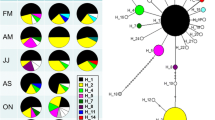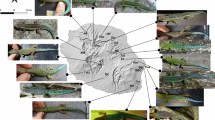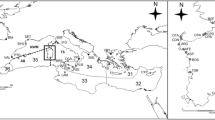Abstract
Oceanic archipelagos are typically rich in endemic taxa, because they offer ideal conditions for diversification and speciation in isolation. One of the most remarkable evolutionary radiations on the Canary Islands comprises the 16 species included in Limonium subsection Nobiles, all of which are subject to diverse threats, and legally protected. Since many of them are single-island endemics limited to one or a few populations, there exists a risk that a loss of genetic variation might limit their long-term survival. In this study, we used eight newly developed microsatellite markers to characterize the levels of genetic variation and inbreeding in L. macrophyllum, a species endemic to the North-east of Tenerife that belongs to Limonium subsection Nobiles. We detected generally low levels of genetic variation over all populations (H T = 0.363), and substantial differentiation among populations (F ST = 0.188; R ST = 0.186) coupled with a negligible degree of inbreeding (F = 0.042). Obligate outcrossing may have maintained L. macrophyllum relatively unaffected by inbreeding despite the species’ limited dispersal ability and the genetic bottlenecks likely caused by a prolonged history of grazing. Although several factors still constitute a risk for the conservation of L. macrophyllum, the lack of inbreeding and the recent positive demographic trends observed in the populations of this species are factors that favour its future persistence.


Similar content being viewed by others
References
Allan GJ, Francisco-Ortega J, Santos-Guerra A, Boerner E, Zimmer EA (2004) Molecular phylogenetic evidence for the geographic origin and classification of Canary Islands Lotus (Fabaceae: Loteae). Mol Phylogenet Evol 32:123–138
Anguita F, Hernán F (2000) The Canary Islands origin: a unifying model. J Volcanol Geoth Res 103:1–26
Antao T, Lopes A, Lopes RJ, Beja-Pereira A, Luikart G (2008) LOSITAN: a workbench to detect molecular adaptation based on a F st -outlier method. BMC Bioinform 9:323
Archbald G, Boyer KE (2014) Potential for spread of Algerian sea lavender (Limonium ramosissimum subsp. provinciale) in tidal marshes. Invasive Plant Sci Manag 7:454–463
Ardévol Gonzales JF, Borgen L, Pérez de Paz PL (1993) Checklist of chromosome numbers counted in Canarian vascular plants. Sommerfeltia 18:1–61
Arrigoni PV, Diana S (1999) Karyology, chorology and bioecology of the genus Limonium (Plumbaginaceae) in Sardinia. Plant Biosyst 133:63–71
Artelari G, Georgiou O (2002) Biosystematic study of the genus Limonium (Plumbaginaceae) in the Aegean area, Greece. III. Limonium on the islands Kithira and Antikithira and the surrounding islets. Nord J Bot 22:483–502
Baker HG (1948) Dimorphism and monomorphism in the Plumbaginaceae I. A survey of the family. Ann Bot-London 12:207–219
Baker HG (1953) Dimorphism and monomorphism in the Plumbaginaceae II. Pollen and stigmata in the genus Limonium. Ann Bot-London 17:433–445
Baker HG (1955) Self-compatibility and establishment after “long-distance” dispersal. Evol Int J org Evol 9:347–349
Baker HG (1966) The evolution, functioning and breakdown of heteromorphic incompability systems. I. The Plumbaginaceae. Evol Int J org Evol 20:349–368
Bañares A, Blanca G, Güemes J, Moreno JC, Ortiz S (2004) Atlas y Libro Rojo de la Flora Vascular Amenazada de España. Dirección General de Conservación de la Naturaleza, Madrid
Barber JC, Francisco Ortega J, Santos-Guerra A, Marrero A, Jansen RK (2000) Evolution of endemic Sideritis (Lamiaceae) in Macaronesia: insights from a chloroplast DNA restriction site analysis. Syst Bot 25:633–647
Barrett SCH, Kohn JR (1991) Genetic and evolutionary consequences of small population size in plants: implications for conservation. In: Falk DA, Holsinger KE (eds) Genetics and conservation of rare plants. Oxford University Press, New York, pp 195–208
Barton NH, Slatkin M (1986) A quasi-equilibrium theory of the distribution of rare alleles in a subdivided population. Heredity 56:409–415
Baudouin L, Lebrun P (2001) An operational Bayesian approach for the identification of sexually reproduced cross-fertilized populations using molecular markers. Acta Hortic 546:81–93
Böhle UR, Hilger HH, Martin WF (1996) Island colonization and the evolution of the insular woody habit in Echium L. (Boraginaceae). Proc Natl Acad Sci USA 93:11740–11745
Boissier E (1848) Plumbaginales. In: Candolle de (ed) Prodromus systematis naturalis regni vegetabilis. Treuttel et Wurz, Paris, pp 617–696
Boorman LA (1967) Limonium vulgare Mill. and L. humile Mill. J Ecol 55:221–232
Carlquist S (1997) Wood anatomy of Argyroxyphium (Asteraceae): adaptive radiation and ecological correlations. J Torrey Bot Soc 124:1–10
Carr GD, Powell EA, Kyhos DW (1986) Self-incompatibility in the Hawaiian Madiinae (Compositae): an exception to Baker’s rule. Evolution Int J org Evolution 42:430–434
Caujapé-Castells J, Tye A, Crawford DJ, Santos-Guerra A, Sakai A, Beaver K, Lobin W, Florens FBV, Moura M, Jardim R, Gómes I, Kueffer C (2010) Conservation of oceanic island floras: present and future global challenges. Perspect Plant Ecol 12:107–129
Caujapé-castells J, Castellano JJ, Ramos R, Henríquez V, Sabbagh I, Quintana-Trujillo FM, Rodríguez JF (2013) Transformer-4 version 2.0.1, a free multi-platform software to quickly reformat genotype matrices of any marker type, and archive them in the Demiurge information system. Mol Ecol Resour 13:484–493
Cornuet JM, Piry S, Luikart G, Estoup A, Solignac M (1999) New methods employing multilocus genotypes to select or exclude populations as origins of individuals. Genetics 153:1989–2000
Courchamp F, Hoffmann BD, Russell JC, Leclerc C, Bellard C (2014) Climate change, sea-level rise, and conservation: kee** island biodiversity afloat. Trends Ecol Evol 29:127–130
Crawford DJ, Archibald JK, Stoermer D, Mort ME, Kelly JK, Santos-Guerra A (2008) A test of Baker’s law: breeding systems and the radiation of Tolpis (Asteraceae) in the Canary Islands. Int J Plant Sci 169:782–791
Crawford DJ, Archibald JK, Kelly JK, Mort ME, Santos-Guerra A (2010) Mixed mating on the “obligately outcrossing” Tolpis (Asteraceae) of the Canary Islands. Plant Spec Biol 25:114–119
Crawford DJ, Anderson GJ, Bernardello G (2011) The reproductive biology of island plants. In: Bramwell D, Caujapé-Castells J (eds) The biology of island floras. Cambridge University Press, Cambridge, pp 11–36
Dulberger R (1975) Intermorph structural differences between stigmatic papillae and pollen grains in relation to incompatibility in Plumbaginaceae. Proc R Soc Lon B Bio 188:257–274
Earl DA, vonHoldt BM (2012) STRUCTURE HARVESTER: a website and program for visualizing STRUCTURE output and implementing the Evanno method. Conserv Genet Resour 4:359–361
Eckert CG, Samis KE, Lougheed SC (2008) Genetic variation across species’ geographical ranges: the central-marginal hypothesis and beyond. Mol Ecol 17:1170–1188
Ellstrand NC, Elam DR (1993) Population genetic consequences of small population size: implications for conservation. Ann Rev Ecol Syst 24:217–242
Erben M (1979) Karyotype differentiation and its consequences in Mediterranean Limonium. Webbia 34:409–417
Erben M (2005) Limonium. In: Castroviejo S, Aedo C, Cirujano S, Laínz M, Montserrat P, Morales R, Muñoz Garmendia F, Navarro C, Paiva J, Soriano C (eds). Flora Iberica, vol. III, 2nd edn. Consejo Superior de Investigaciones Científicas, Madrid, pp 2–143
Fernández-Palacios JM, de Nascimento L, Otto R, Delgado JD, García-del-Rey E, Arévalo JR, Whittaker RJ (2011) A reconstruction of Palaeo-Macaronesia, with particular reference to the long-term biogeography of the Atlantic island laurel forests. J Biogeogr 38:226–246
Foll M, Gaggiotti OE (2008) A genome scan method to identify selected loci appropriate for both dominant and codominant markers: a Bayesian perspective. Genetics 180:977–993
Francisco-Ortega J, Santos-Guerra A, Kim S-C, Crawford DJ (2000) Plant genetic diversity in the Canary Islands: a conservation perspective. Am J Bot 87:909–919
Frankham R (1997) Do island populations have less genetic variation than mainland populations? Heredity 78:311–327
Frankham R (1998) Inbreeding and extinction: island populations. Conserv Biol 12:665–675
Frankham R (2005) Genetics and extinction. Biol Conserv 126:131–140
Frankham R, Ballou JD, Briscoe DA (2010) Introduction to conservation genetics, 2nd edn. Cambridge University Press, Cambridge
Franks SJ (2010) Genetics, evolution and conservation of island plants. J Plant Biol 53:1–9
García-Verdugo C, Forrest AD, Fay MF, Vargas P (2010) The relevance of gene flow in metapopulation dynamics of an oceanic island endemic, Olea europaea subsp. guanchica. Evol Int J org Evol 64:3525–3536
García-Verdugo C, Sajeva M, La Mantia T, Harrouni C, Msanda F, Caujapé-Castells J (2015) Do island populations really have lower genetic variation than mainland populations? Effects of selection and distribution range of genetic diversity estimates. Mol Ecol 24:726–741
González-Pérez MA, Lledó MD, Lexer C, Fay M, Marrero M, Bañares-Baudet A, Carqué E, Sosa PA (2009) Genetic diversity and differentiation in natural and reintroduced populations of Bencomia exstipulata and comparisons with B. caudata (Rosaceae) in the Canary Islands: an analysis using microsatellites. Bot J Linn Soc 160:429–441
Goudet (2002) FSTAT, a program to estimate and test gene diversities and fixation indices, version 2.9.3.2. http://www2.unil.ch/popgen/softwares/fstat.htm. Accessed 15 Nov 2015
Goudet J, Raymond M, de Meeüs R, Rousset F (1996) Testing differentiation in diploid populations. Genetics 144:1933–1940
Grant P, Grant R (2009) The secondary contact phase of allopatric speciation in Darwin’s finches. Proc Natl Acad Sci USA 106:20141–20148
Guo SW, Thompson EA (1992) Performing the exact test of Hardy–Weinberg proportion for multiple alleles. Biometrics 48:361–372
Hamrick JL, Trapnell DW (2011) Using population genetic analyses to understand seed dispersal patterns. Acta Oecol 37:641–649
Hendry AP, Grant PR, Grant BR, Ford HA, Brewer MJ, Podos J (2006) Possible human impacts on adaptive radiation: beak size bimodality in Darwin’s finches. Proc R Soc B 273:1887–1894
Ingvarsson PK (2001) Restoration of genetic variation lost—the genetic rescue hypothesis. Trends Ecol Evol 16:62–63
Karis PO (2004) Taxonomy, phylogeny and biogeography of Limonium sect. Pteroclados (Plumbaginaceae), based on morphological data. Bot J Linn Soc 2004:461–482
Kier G, Kreft H, Lee TM, Jetz W, Ibisch PL, Nowicki C, Mutke J, Barthlot W (2009) A global assessment of endemism and species richness across island and mainland regions. Proc Natl Acad Sci USA 106:9322–9327
Kisel Y, Barraclough TG (2010) Speciation has a spatial scale that depends on levels of gene flow. Am Nat 175:316–334
Koutstaal BP, Markusse MM, de Munck W (1987) Aspects of seed dispersal by tidal movements. In: Huiskes AHL, Bloom CWPM, Rozema J (eds) Vegetation between land and sea. Junk, Dordrecht, pp 226–235
Kreft H, Jetz W, Mutke J, Kier G, Barthlott W (2008) Global diversity of island floras from a macroecological perspective. Ecol Lett 11:116–127
Lacy RC (1987) Loss of genetic diversity from managed populations: interacting effects of drift, mutation, immigration, selection, and population subdivision. Conserv Biol 1:143–158
Lledó MD, Crespo MB, Fay MF, Chase MW (2005) Molecular phylogenetics of Limonium and related genera (Plumbaginaceae): biogeographical and systematic implications. Am J Bot 92:1189–1198
Lledó MD, Karis PO, Crespo MB, Fay MF, Chase MW (2011) Endemism and evolution in Macaronesian and Mediterranean Limonium taxa. In: Bramwell D, Caujapé-Castells J (eds) The biology of island floras. Cambridge University Press, Cambridge, pp 325–337
Luikart G, Allendorf FW, Cornuet JM, Sherwin WB (1998) Distortion of allele frequency distributions provides a test for recent population bottlenecks. J Hered 89:238–247
Martín JL, Bethencourt J, Cuevas-Agulló E (2012) Assessment of global warming of the island of Tenerife, Canary Islands (Spain). Trends in minimum, maximum and mean temperatures since 1944. Clim Change 114:343–355
Mayr E (1942) Systematics and the origin of species. Columbia University Press, New York
Meimberg H, Abele T, Bräuchler C, McKay JK, Pérez de Paz PL, Heubl G (2006) Molecular evidence for adaptive radiation of Micromeria Benth. (Lamiaceae) on the Canary Islands as inferred from chloroplast and nuclear DNA sequences and ISSR fingerprint data. Mol Phylogenet Evol 41:566–578
Meloni M, Reid A, Caujapé-Castells J, Marrero A, Fernández-Palacios JM, Mesa-Coelo RA, Conti E (2013) Effects of clonality on the genetic variability of rare, insular species: the case of Ruta microcarpa from the Canary Islands. Ecol Evol 3:1569–1579
Meloni M, Reid A, Caujapé-Castells J, Soto M, Fernández-Palacios JM, Conti E (2015) High genetic diversity and population structure in the endangered Canarian endemic Ruta oreojasme (Rutaceae). Genetica 143:571–580
Merwin L, He T, Lamont BB, Enright NJ, Krauss SL (2012) Low rate of between-population seed dispersal restricts genetic connectivity and metapopulation dynamics in a clonal shrub. PLoS One 7:e50974
Miller MP (2005) Alleles In Space (AIS): computer software for the joint analysis of interindividual spatial and genetic information. J Hered 96:722–724
Mills LS, Allendorf FW (1996) The one-migrant-per-generation rule in conservation and management. Conserv Biol 10:1509–1518
Moreno JC (2008) Lista Roja 2008 de la flora vascular española. Dirección General de Medio Natural y Política Forestal (Ministerio de Medio Ambiente, y Medio Rural y Marino, y Sociedad Española de Biología de la Conservación de Plantas), Madrid
Mort ME, Soltis DE, Soltis PS, Francisco-Ortega J, Santos-Guerra A (2002) Phylogenetics and evolution of the Macaronesian clade of Crassulaceae inferred from nuclear and chloroplast sequence data. Syst Bot 27:271–288
Navascués M, Emerson BC (2007) Natural recovery of genetic diversity by gene flow in reforested areas of the endemic Canary Island pine, Pinus canariensis. Forest Ecol Manag 244:122–128
Nei M (1973) Analysis of gene diversity in subdivided populations. Proc Natl Acad Sci USA 70:3321–3323
Orr HA, Betancourt AJ (2001) Haldane’s sieve and adaptation from the standing genetic variation. Genetics 157:875–884
Paetkau D, Calvert W, Stirling I, Strobeck C (1995) Microsatellite analysis of population structure in Canadian polar bears. Mol Ecol 4:347–354
Paetkau D, Slade R, Burden M, Estoup A (2004) Direct, real-time estimation of migration rate using assignment methods: a simulation-based exploration of accuracy and power. Mol Ecol 13:55–65
Pérez de Paz J, Caujapé-Castells J (2013) A review of the allozyme data set for the Canarian endemic flora: causes of the high diversity levels and implications for conservation. Ann Bot 111:1059–1073
Petit R, Hampe A (2006) Some evolutionary consequences of being a tree. Ann Rev Ecol Evol Syst 37:187–214
Piry S, Luikart G, Cornuet JM (1999) BOTTLENECK: A computer program for detecting recent reductions in the effective population size using allele frequency data. J Hered 90:502–503
Piry S, Alapetite A, Cornuet J-M, Paetkau D, Baudouin L, Estoup A (2004) GeneClass2: a software for genetic assignment and first-generation migrant detection. J Hered 95:536–539
Pritchard JK, Stephens M, Donnelly P (2000) Inference of population structure using multilocus genotype data. Genetics 155:945–959
Rando JC, Cabrera VM, Larruga JM, Hernández M, González Pinto AM, Bandelt H-J (1999) Phylogeographic patterns of mtDNA reflecting the colonization of the Canary Islands. Ann Hum Gen 63:413–428
Rannala B, Mountain JL (1997) Detecting immigration by using multilocus genotypes. Proc Natl Acad Sci USA 94:9197–9221
Reyes-Betancort JA, Santos Guerra A, Guma IR, Humphries CJ, Carine MA (2008) Diversity, ratity and the evolution and conservation of the Canary Islands endemic flora. Anales Jard Bot Madrid 65:25–45
Richards AJ (1997) Plant breeding systems. Chapman & Hall, London
Riley L, McGlaughlin ME, Helenurm K (2010) Genetic diversity following demographic recovery in the insular endemic plant Galium catalinense subsp. acrispum. Conserv Genet 11:2015–2025
Rousset F (2008) Genepop’007: a complete reimplementation of the Genepop software for Windows and Linux. Mol Ecol Resour 8:103–106
Rozen S, Skaletsky H (2000) Primer3 on the WWW for general users and for biologist programmers. In: Krawetz S, Misener S (eds) Bioinformatics methods and protocols: methods in molecular biology. Humana Press, Totowa, pp 365–386
Slatkin M (1987) Gene flow and the geographic structure of natural populations. Science 236:787–792
Slatkin M (1995) A measure of population subdivision based on microsatellite allele frequencies. Genetics 139:457–462
Sosa PA, González-Pérez MA, Moreno C, Clarke JB (2010) Conservation genetics of the endangered endemic Sambucus palmensis Link (Sambucaceae) from the Canary Islands. Conserv Genet 11:2357–2368
Suárez-García C, Pérez de Paz J, Febles R, Caujapé-Castells J (2009) Genetic diversity and floral dimorphism in Limonium dendroides (Plumbaginaceae), a woody Canarian species on the way of extinction. Plant Syst Evol 280:105–117
van Oosterhout C, Hutchinson WF, Wills DPM, Shipley P (2004) micro-checker: software for identifying and correcting genoty** errors in microsatellite data. Mol Ecol Notes 4:535–538
Vekemans X, Lefebvre C, Belalia I, Meerts P (1990) The evolution and breakdown of the heteromorphic incompatibility system of Armeria maritima revisited. Evol Trend Plant 4:15–23
Vucetich JA, Waite TA (2000) Is one migrant per generation sufficient for the genetic management of fluctuating populations? Anim Conserv 3:261–266
Weir BS, Cockerham CC (1984) Estimating F-statistics for the analysis of population structure. Evol Int J org Evol 38:1358–1370
Whittaker RJ, Fernández-Palacios JM (2007) Island biogeography. Ecology, evolution and conservation, 2nd edn. Oxford University Press, Oxford
Wright S (1931) Evolution in Mendelian populations. Genetics 16:97–159
Wright S (1943) Isolation by distance. Genetics 28:114–138
Wright S (1978) Evolution and the genetics of populations. Volume 4. Variability within and among natural populations. The University of Chicago Press, Chicago
Young AG, Brown AHD (1999) Paternal bottlenecks in fragmented populations of the grassland daisy Rutidosis leptorrhynchoides. Genet Res 73:111–117
Zhao R, **a H, Lu B-R (2009) Fine-scale genetic structure enhances biparental inbreeding by promoting mating events between more related individuals in wild soybean (Glycine soja; Fabaceae) populations. Am J Bot 96:1138–1147
Acknowledgements
We thank B. Keller for her assistance in the laboratory, A. Reyes-Betancort for his advice and help in the field, and M. Meloni for her contribution to the scientific development of this study. We also thank the editor and two anonymous reviewers for their constructive comments, which helped us to improve this manuscript. Collection permits were granted by the Consejería de Medio Ambiente del Gobierno de Canarias and by the Cabildo de Tenerife. This research was funded with a post-doctoral fellowship of the Spanish Ministry of Education to A. Jiménez, with a G. and A. Claraz-Schenkung Foundation grant to (A) Jiménez and (B) Weigelt for field work, and with funding from the University of Zurich.
Author information
Authors and Affiliations
Corresponding author
Ethics declarations
Conflict of interest
The authors declare that they have no conflict of interest.
Electronic supplementary material
Below is the link to the electronic supplementary material.
Rights and permissions
About this article
Cite this article
Jiménez, A., Weigelt, B., Santos-Guerra, A. et al. Surviving in isolation: genetic variation, bottlenecks and reproductive strategies in the Canarian endemic Limonium macrophyllum (Plumbaginaceae). Genetica 145, 91–104 (2017). https://doi.org/10.1007/s10709-017-9948-z
Received:
Accepted:
Published:
Issue Date:
DOI: https://doi.org/10.1007/s10709-017-9948-z




